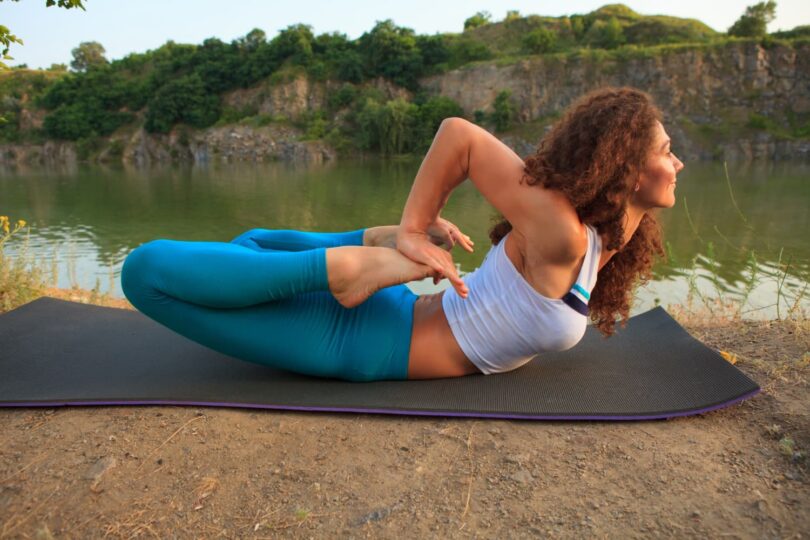Introduction
Peaceful yoga practices are a wonderful way to bring tranquility and mindfulness into your daily routine. By incorporating gentle yoga poses, mindful breathing techniques, and meditation, you can experience both physical and mental wellness. This article will guide you through the benefits of peaceful yoga, key elements, popular poses, and how to integrate these practices into your daily life. Let’s begin this journey to a stress-free, healthier you.
Table of Contents
Introduction to Peaceful Yoga Practices
What is Peaceful Yoga?
Peaceful yoga is all about creating a serene and calming practice that promotes relaxation and mindfulness. Unlike more vigorous styles of yoga, peaceful yoga focuses on slow, deliberate movements, gentle stretches, and deep breathing. The goal is to connect the mind and body, helping to reduce stress and anxiety while improving overall well-being.
Importance of Incorporating Peace in Yoga
In today’s fast-paced world, finding moments of peace can be challenging. Incorporating peaceful yoga into your routine can help create a sense of calm and balance. It provides a break from the chaos, allowing you to reconnect with yourself. Whether you’re a beginner or a seasoned yogi, peaceful yoga offers numerous benefits that can enhance your quality of life.
Physical Benefits of Peaceful Yoga
Enhancing Flexibility and Strength
One of the primary physical benefits of peaceful yoga is its ability to enhance flexibility and strength. By gently stretching and holding poses, you can gradually improve your range of motion. Over time, this can lead to increased flexibility, making everyday movements easier and reducing the risk of injury.
In addition to flexibility, peaceful yoga helps build strength. Holding poses engages various muscle groups, promoting muscle tone and endurance. Unlike high-impact exercises, yoga provides a low-risk way to build strength without putting undue stress on the joints.
Improving Posture and Balance
Good posture is essential for overall health, and peaceful yoga can significantly improve it. Many yoga poses focus on alignment and balance, which can help correct poor posture habits. Regular practice encourages awareness of your body, helping you maintain proper alignment in daily activities.
Moreover, improved balance is another key benefit. Yoga poses that require stability challenge your body’s equilibrium, enhancing your ability to stay steady and coordinated. This can be particularly beneficial as you age, helping to prevent falls and maintain independence.
Mental and Emotional Benefits of Peaceful Yoga
Reducing Stress and Anxiety
Peaceful yoga is a powerful tool for reducing stress and anxiety. The combination of gentle movements, deep breathing, and mindfulness helps calm the nervous system. By focusing on the present moment, you can let go of worries and stressors, creating a sense of inner peace.
Deep breathing exercises, such as pranayama, are particularly effective in reducing stress. These techniques encourage slow, controlled breaths, which can lower heart rate and blood pressure. This, in turn, triggers the body’s relaxation response, reducing feelings of anxiety and promoting a sense of calm.
Enhancing Mindfulness and Emotional Well-being
Mindfulness is a core component of peaceful yoga. By paying attention to your breath and body, you cultivate a state of awareness that extends beyond the yoga mat. This mindfulness can help you manage emotions more effectively, improving your overall emotional well-being.
Incorporating mindfulness into your daily life can also lead to greater self-awareness and acceptance. It encourages you to be present, appreciate the moment, and respond to challenges with a calm and balanced mindset. This can enhance your relationships, productivity, and overall happiness.
Related Article: 2 Person Yoga Poses: Ultimate Guide for Beginners to Advanced
Popular Peaceful Yoga Poses
Beginner-Friendly Peaceful Yoga Poses
Child’s Pose
Child’s Pose, or Balasana, is a deeply restorative pose that is perfect for beginners. It gently stretches the back, hips, and thighs while promoting relaxation. To practice Child’s Pose, kneel on the floor, touch your big toes together, and sit back on your heels. Then, fold forward, extending your arms in front of you or alongside your body. Rest your forehead on the mat and breathe deeply.
Corpse Pose
Corpse Pose, known as Savasana, is the ultimate relaxation pose. It helps to calm the mind and reduce stress. Lie flat on your back with your legs extended and arms relaxed at your sides, palms facing up. Close your eyes and focus on your breath, allowing your body to fully relax. This pose is often practiced at the end of a yoga session to integrate the benefits of your practice.
Cat-Cow Pose
Cat-Cow Pose, or Marjaryasana-Bitilasana, is a gentle flow that warms up the spine and releases tension. Begin on your hands and knees in a tabletop position. Inhale, arch your back and lift your head and tailbone (Cow Pose). Exhale, round your spine, and tuck your chin to your chest (Cat Pose). Repeat this flow several times, synchronizing your breath with your movements.
Intermediate Peaceful Yoga Poses
Warrior I and II
Warrior I (Virabhadrasana I) and Warrior II (Virabhadrasana II) are powerful standing poses that build strength and stability.
- For Warrior I, step one foot back, bend the front knee, and raise your arms overhead. Keep your hips square to the front.
- For Warrior II, extend your arms out to the sides, parallel to the floor, and gaze over your front hand. Both poses engage the legs, core, and arms while improving focus and balance.
Tree Pose
Tree Pose, or Vrksasana, enhances balance and concentration. Stand on one leg and place the sole of the other foot on the inner thigh or calf (avoiding the knee). Bring your hands together in front of your heart or extend them overhead. Focus on a point in front of you to maintain balance. Tree Pose strengthens the legs and improves posture.
Bridge Pose
Bridge Pose, or Setu Bandhasana, opens the chest and stretches the spine. Lie on your back with your knees bent and feet hip-width apart. Press your feet into the mat, lift your hips, and clasp your hands under your back. Hold for several breaths, then slowly lower down. This pose is excellent for relieving back tension and improving spinal flexibility.
Advanced Peaceful Yoga Poses
Headstand
Headstand, or Sirsasana, is an advanced inversion that requires strength and balance. Begin by kneeling and placing your forearms on the mat, interlacing your fingers. Place the crown of your head on the floor, with the back of your head cradled in your hands. Lift your hips, walk your feet closer to your head, and gently kick up into the pose. Hold for several breaths, then lower down with control. Practicing against a wall can provide support as you build confidence.
Crow Pose
Crow Pose, or Bakasana, is an arm balance that builds upper body strength and focus. Start in a squat with your hands on the mat, shoulder-width apart. Place your knees on the backs of your upper arms, shift your weight forward, and lift your feet off the ground. Balance on your hands, keeping your gaze forward. Crow Pose strengthens the arms, wrists, and core while improving concentration.
Lotus Pose
Lotus Pose, or Padmasana, is a classic seated meditation pose. Sit with your legs extended, bend one knee, and place the foot on the opposite thigh. Repeat with the other leg, crossing your legs at the ankles. Rest your hands on your knees and focus on your breath. Lotus Pose opens the hips and promotes deep relaxation and meditation.
Creating a Peaceful Yoga Environment
Setting Up a Yoga Space
Creating a dedicated space for your peaceful yoga practice is essential for a tranquil experience. Start by choosing a quiet location in your home where you won’t be disturbed. A corner of a room, a balcony, or even a small garden can be ideal.
Ensure the space is clean and clutter-free. A tidy environment promotes a clear mind. Use a comfortable yoga mat that provides adequate cushioning and support. Having a few props like blocks, straps, and bolsters can be helpful, especially for beginners. These props aid in achieving correct alignment and make poses more accessible.
Lighting plays a crucial role in setting the mood. Soft, natural light is best, but if that’s not available, opt for warm, dimmable lights. Avoid harsh, bright lights that can be distracting.
Music and Aromatherapy for Peaceful Yoga
Incorporating music and aromatherapy can significantly enhance your peaceful yoga practice. Soft, calming music or nature sounds can help you relax and focus. Create a playlist that suits your preference, or use apps that offer ready-made yoga soundtracks.
Aromatherapy can further enrich your experience. Essential oils like lavender, chamomile, and sandalwood are known for their calming properties. You can use an oil diffuser to spread the fragrance throughout your space. If you prefer, light a few scented candles to create a serene ambiance.
Combining these elements can transform your yoga practice into a holistic sensory experience. Not only does it help in physical relaxation, but it also soothes the mind, allowing you to achieve a deeper state of mindfulness and tranquility.
Integrating Peaceful Yoga into Daily Life
Developing a Consistent Yoga Routine
Making peaceful yoga a part of your daily life can seem challenging, but with a few simple steps, it becomes easier. Start by setting a specific time for your practice each day. Whether it’s in the morning to start your day calmly or in the evening to unwind, consistency is key.
Begin with short sessions, around 10-15 minutes, and gradually increase the duration as you become more comfortable. It’s important to listen to your body and not push yourself too hard. Even a brief practice can have significant benefits.
Create a routine that includes a mix of poses, breathing exercises, and meditation. This variety keeps your practice engaging and addresses different aspects of your well-being. Having a consistent routine helps build discipline and makes it easier to stick with your practice over time.
Overcoming Common Obstacles
Life can be busy, and it’s easy to let distractions interfere with your yoga practice. However, there are ways to overcome these obstacles. Set clear boundaries with family or housemates about your yoga time to minimize interruptions. Turning off electronic devices or setting them to Do Not Disturb mode can also help create a more focused environment.
If motivation is an issue, find a yoga buddy or join an online class. Practicing with others can provide accountability and make the experience more enjoyable. Additionally, remind yourself of the benefits you experience from regular practice, such as reduced stress and improved mood, to stay motivated.
Combining Yoga with Other Peaceful Practices
Integrating peaceful yoga with other calming activities can enhance its benefits. For instance, combining yoga with Tai Chi can improve your balance and mindfulness. Both practices focus on slow, deliberate movements and deep breathing, making them a perfect pair.
Another practice to consider is mindful walking. Take a few minutes each day to walk slowly, paying attention to each step and your surroundings. This simple exercise can complement your yoga practice by further promoting mindfulness and relaxation.
Incorporating peaceful yoga into your daily routine doesn’t have to be overwhelming. By developing a consistent practice, overcoming common obstacles, and combining yoga with other peaceful activities, you can create a balanced and fulfilling lifestyle.
FAQs on Peaceful Yoga Practices
What is the best time to practice peaceful yoga?
The best time to practice peaceful yoga is when you can dedicate uninterrupted time to it. Many people prefer morning sessions to start their day with a calm mindset. However, evening practices can also be beneficial for unwinding and releasing the day’s stress. Choose a time that fits your schedule and allows you to be consistent.
Can peaceful yoga help with insomnia?
Yes, peaceful yoga can be very effective in helping with insomnia. Gentle poses and breathing exercises promote relaxation and reduce stress, which can improve sleep quality. Incorporating a short, calming yoga routine before bed can signal your body that it’s time to wind down and prepare for sleep.
How long should a peaceful yoga session last?
The length of a peaceful yoga session can vary based on your schedule and experience level. Beginners might start with 10-15 minutes per session, gradually increasing to 30-60 minutes as they become more comfortable. Even short sessions can provide significant benefits if practiced regularly.
Is peaceful yoga suitable for all ages?
Absolutely! Peaceful yoga is gentle and adaptable, making it suitable for individuals of all ages and fitness levels. Modifications and props can be used to accommodate different needs and abilities. It’s a great way for seniors, adults, and even children to enjoy the benefits of yoga.
Do I need any special equipment to start peaceful yoga?
You don’t need much to start practicing peaceful yoga. A good quality yoga mat provides cushioning and support. Props like blocks, straps, and bolsters can be helpful, especially for beginners or those with limited flexibility. Comfortable clothing that allows free movement is also essential.
Can I practice peaceful yoga if I have a medical condition?
Peaceful yoga is generally safe for most people, but it’s always best to consult with a healthcare provider if you have any medical conditions or concerns. They can advise on any modifications or precautions you should take. Many poses can be adapted to accommodate various health issues, making yoga a versatile practice.
Conclusion
Peaceful yoga practices offer a pathway to tranquility and mindfulness in our often hectic lives. By incorporating gentle poses, mindful breathing, and meditation, you can achieve both physical and mental well-being. Whether you’re a beginner or an experienced yogi, there’s always room to deepen your practice and reap the benefits.
Creating a dedicated yoga space and integrating elements like music and aromatherapy can enhance your experience. Developing a consistent routine, addressing common obstacles, and combining yoga with other peaceful activities can make this practice a natural part of your daily life.
From reducing stress and anxiety to improving flexibility and balance, peaceful yoga has something to offer everyone. It’s a gentle yet powerful way to care for your body and mind, fostering a sense of calm and balance.
So, roll out your mat, find a quiet space, and let the journey to a more peaceful and mindful life begin.
Related Article: Chair Exercises for Belly: Effective Workouts You Can Do Anywhere







